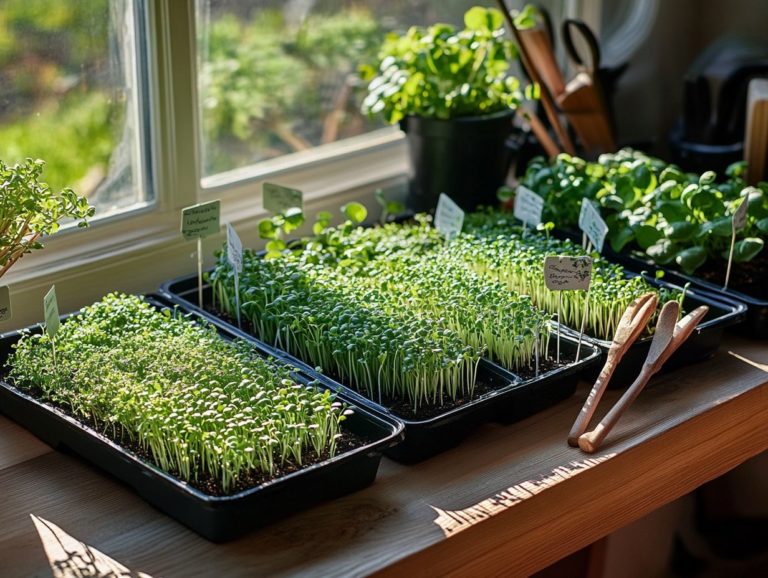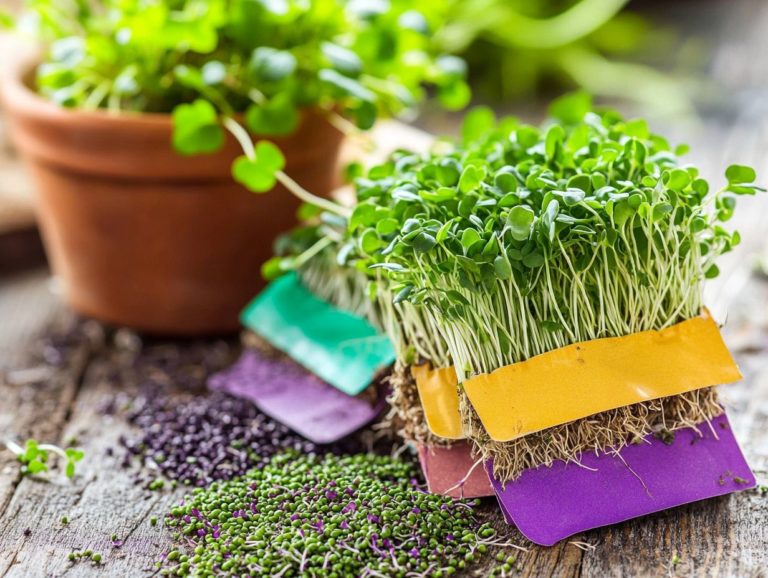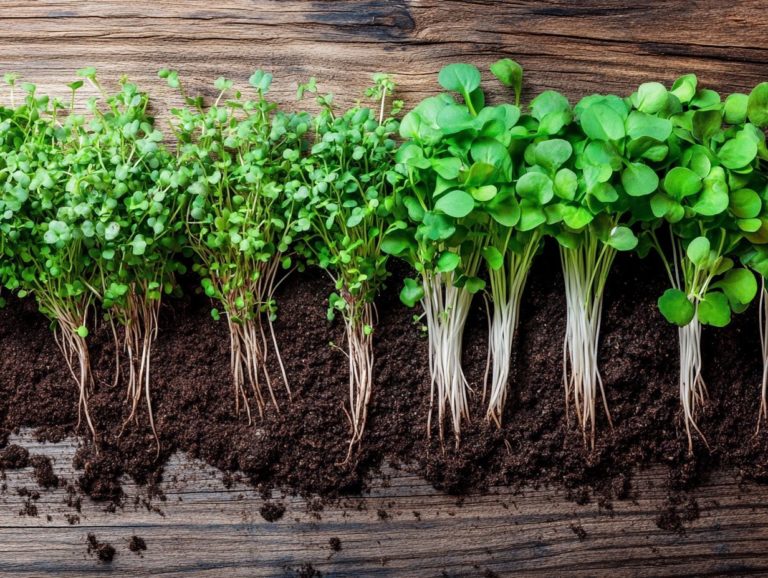The Impact of Water Quality on Microgreens
Microgreens are tiny, nutrient-packed wonders that have captured the culinary spotlight. They are celebrated for their vibrant flavors and impressive health benefits. The quality of water you use to cultivate these greens is paramount and significantly influences their growth and nutrient content.
Let s dive in and discover how to cultivate amazing microgreens! This article explores the definition and various uses of microgreens while highlighting how water quality impacts their development. You’ll gain insight into the key factors that affect this essential resource.
Explore effective testing methods and discover ways to enhance water quality. This ensures your microgreens flourish beautifully. Elevate your microgreens game to new heights, embracing the principles of dirt-free farming!
Contents
Key Takeaways:
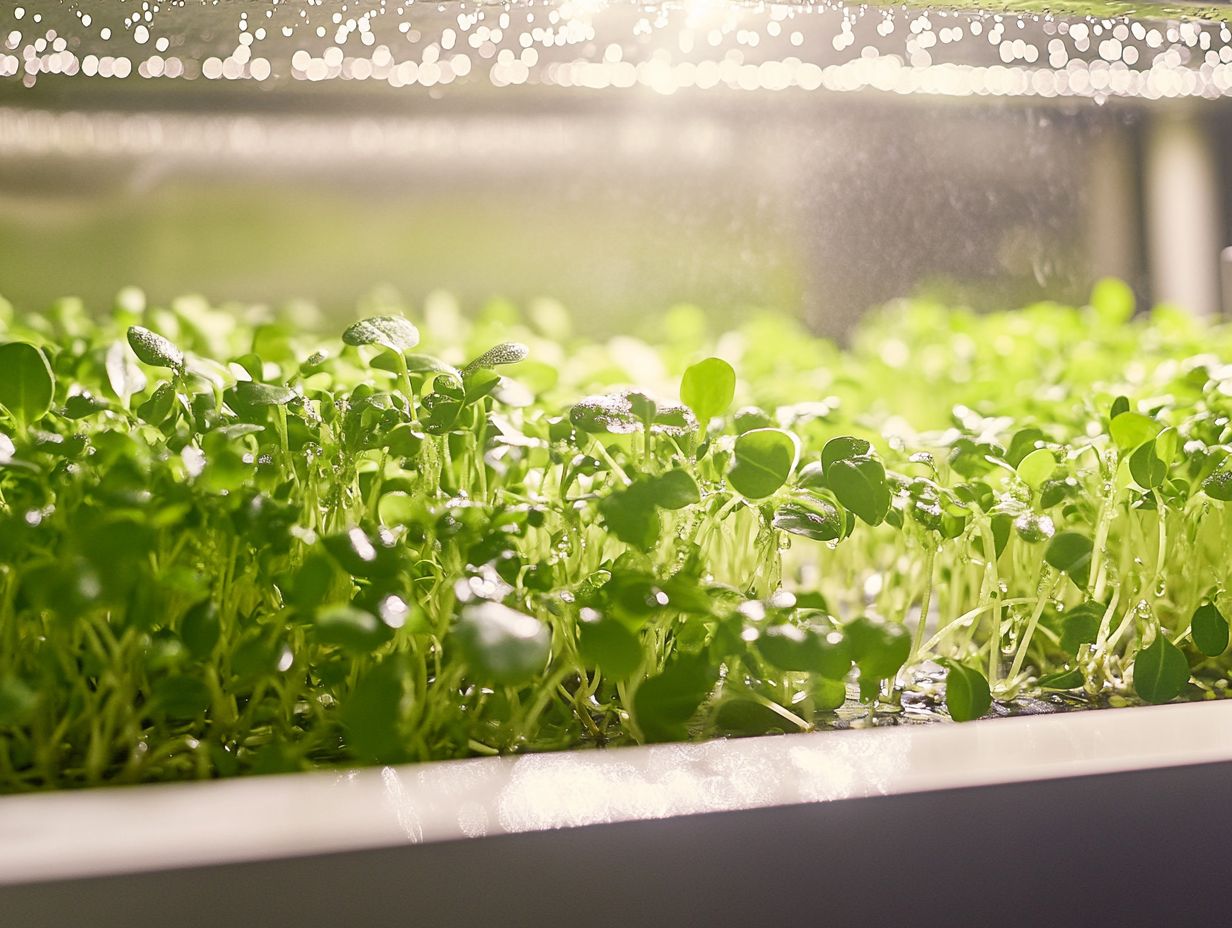
- Water quality is crucial for the growth and nutrient content of microgreens.
- The source of water and presence of contaminants can greatly affect its quality.
- Regular testing and monitoring can significantly improve water quality.
What are Microgreens?
Microgreens are young, edible plants harvested just after the germination phase. They’re known for their vibrant colors, intense flavors, and impressive nutritional benefits. This makes them a favorite among eco-conscious consumers who appreciate flavorful produce.
You ll often find them in salads, garnishes, and various culinary creations. They support sustainable agricultural practices by promoting local produce and minimizing the carbon footprint tied to food transportation.
With innovative soilless cultivation techniques, like growing plants in nutrient-rich water without soil, bamboo grow mats, and vertical farming, you can efficiently cultivate these nutrient powerhouses in urban environments.
Definition and Uses
Microgreens are essentially young seedlings from edible vegetables and herbs, brimming with essential nutrients and an array of flavors that make them a sought-after addition in the culinary world.
These vibrant greens brighten up your plate and pack a concentrated punch of vitamins, minerals, and antioxidants. They elevate everyday meals, with chefs and home cooks weaving microgreens into salads, sandwiches, and garnishes.
The nutritional density of these petite powerhouses is impressive. They feature high levels of vitamins C (great for your immune system), E, and K (important for bone health), along with crucial phytochemicals that contribute to overall health and wellness. Microgreens can transform simple plates into artistic culinary masterpieces, making each dish more nutritious and visually stunning.
The Importance of Water Quality for Microgreens
Water quality is crucial in cultivating microgreens. It directly influences their growth, flavor, and nutritional value. This is particularly true in hydroponic systems, where water is the lifeblood of the operation.
When water quality falters, it can introduce harmful contaminants that hinder healthy growth. This may escalate the need for chemical pesticides, ultimately impacting the environmental footprint of microgreens cultivation.
For the eco-conscious consumer, grasping the connection between water quality and plant nutrition is essential for embracing sustainable practices in urban agriculture, including water conservation techniques.
Start your microgreens journey today, and enjoy the vibrant flavors and health benefits they bring to your table!
Effects on Growth and Nutrient Content
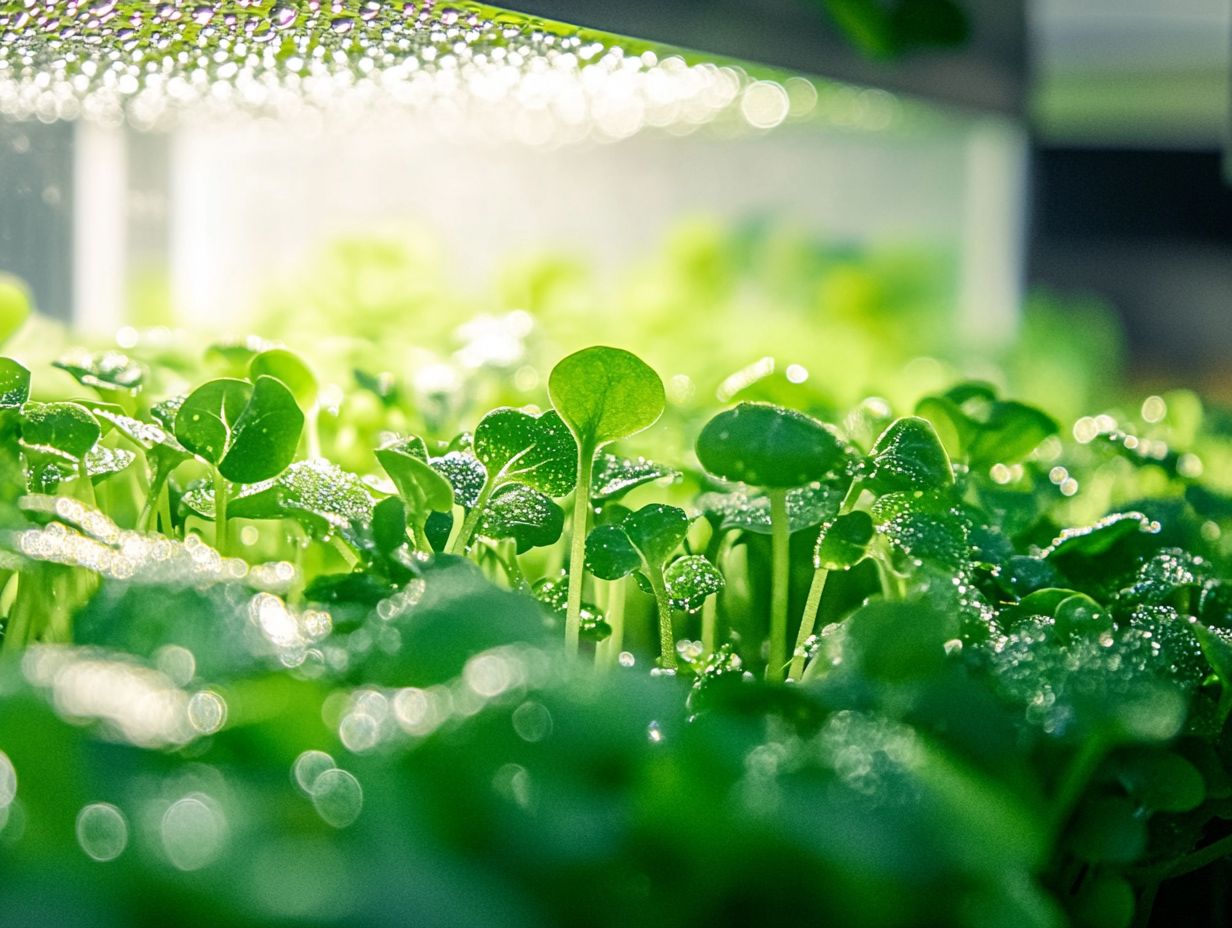
The impact of water quality on the growth stage and nutrient content of microgreens is significant. When conditions are optimal, you enhance flavor and health benefits.
In contrast, poor quality can lead to stunted growth and a decline in nutritional value. This decline affects the germination phase of these fast-growing plants.
Key factors such as pH levels, dissolved oxygen (the amount of oxygen in the water that plants need), and the presence of contaminants like heavy metals are crucial in shaping how your microgreens develop. A slightly acidic pH can promote nutrient absorption, resulting in more vibrant colors and improved taste.
High salinity can hinder germination rates. You must test your water regularly to ensure your microgreens thrive!
By prioritizing water quality, your microgreens will not only thrive more effectively but will also boast higher levels of essential vitamins, minerals, and antioxidants. Additionally, understanding the importance of light quality for microgreens contributes to healthier eating habits and promotes the consumption of flavorful produce.
Factors Affecting Water Quality for Microgreens
When cultivating microgreens, several crucial factors influence water quality. Consider the source of your water and any potential contaminants that could disrupt growth, such as those arising from agricultural soils.
Pay attention to various physical and chemical properties to create ideal conditions for your microgreens to thrive.
Source of Water
The choice of water source for cultivating microgreens plays a crucial role in their growth and quality. Options abound, from the convenience of tap water to the sustainability of rainwater collection.
As an urban farmer, exploring various water sources can boost yield and nutrient content. It may surprise you that tap water often has chlorine and other chemicals that can slow down your seedlings.
On the other hand, rainwater harvesting presents a natural, chemical-free alternative. However, it necessitates an effective filtration system to eliminate contaminants.
Utilizing advanced purification systems can ensure you re using the cleanest water. This aligns with sustainable practices and effective agricultural techniques.
Striking a balance between the costs of these treatments and their benefits is essential for anyone passionate about urban agriculture and high-quality produce.
By grasping these nuances, you can make informed choices that promote healthy microgreen growth while embracing environmentally responsible methods.
Presence of Contaminants
The presence of contaminants in the water you use for cultivating microgreens can pose significant challenges. These include the risk of soil-borne diseases and an increased dependence on chemical pesticides.
These issues not only threaten the health of your plants but can also impact overall crop yield, compromising both nutritional value and marketability.
Contaminants such as heavy metals, pathogenic bacteria, and chemical runoff can diminish the quality of your microgreens. This makes them less safe for consumption and affects the sensory qualities of your produce.
Effective water quality management is essential to navigate these challenges. By ensuring the water you use is free from harmful substances, you can cultivate healthier crops that flourish.
This not only enhances consumer health but also promotes agricultural sustainability, contributing to better ecological outcomes.
Testing and Monitoring Water Quality for Microgreens
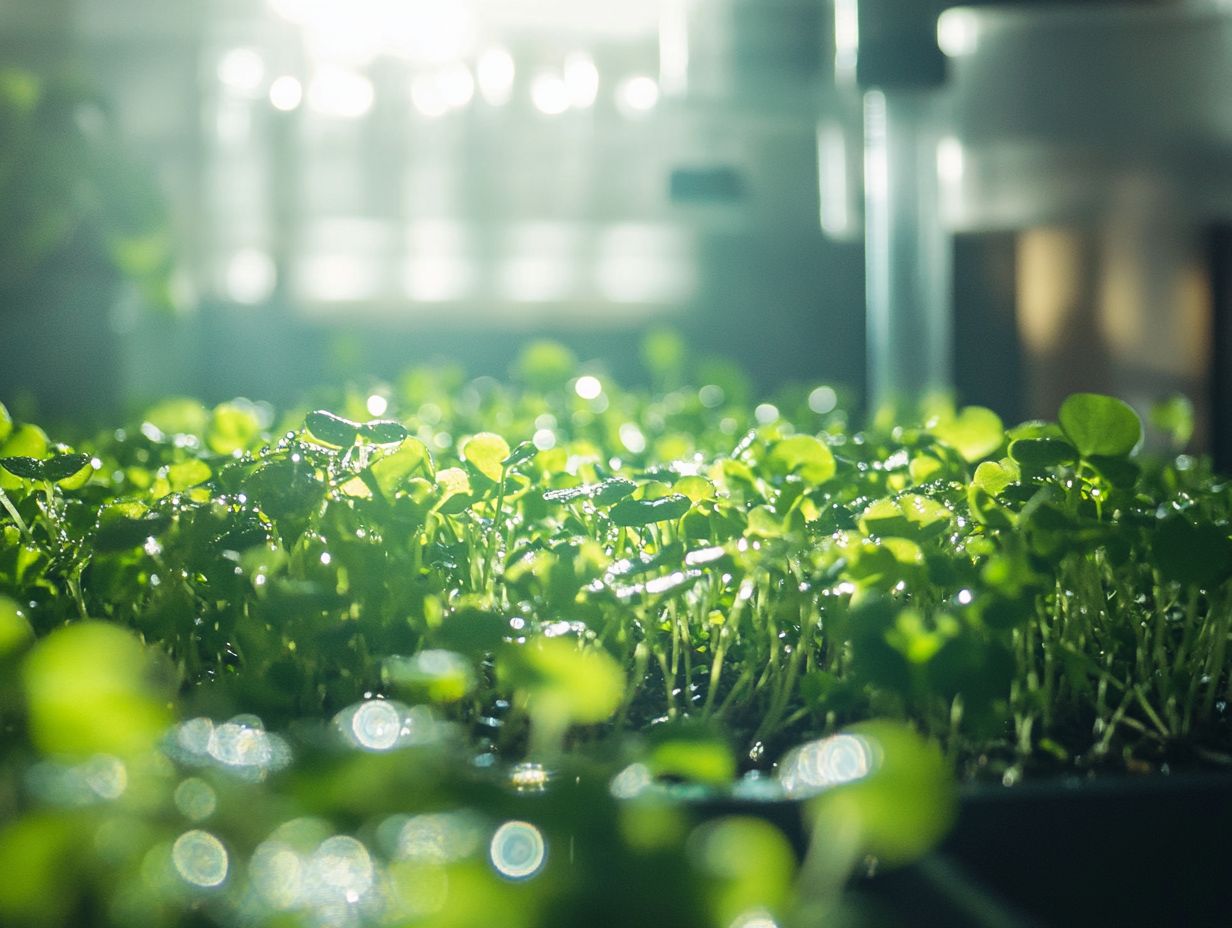
Regularly testing and monitoring water quality is crucial for cultivating microgreens. By ensuring that parameters like pH, how basic or acidic the water is, and soluble salts stay within optimal ranges, you set the stage for vibrant and healthy growth.
Embrace principles of agricultural research to enhance your microgreens’ development!
Methods and Frequency
Effective methods for water quality testing involve regularly checking pH levels and monitoring soluble salts. The recommended frequencies should be tailored to your specific cultivation method and water source for microgreens to ensure optimal conditions for growth.
Understanding your microgreens water needs is crucial! Different microgreens come with distinct water quality requirements, meaning frequent testing is key ideally every week for hydroponic systems and biweekly for soil-based setups. By using precise testing kits and monitoring tools, you can gain immediate insights into crucial parameters like nutrient levels, contaminants, and the overall health of your microgreens.
These factors can significantly influence your plants’ growth rates and overall health. Creating the optimal environment promotes vigorous microgreen development while enhancing their flavor and nutritional value. If you’re serious about growing vibrant microgreens, don’t miss out on exploring watering techniques for thriving microgreens and making water quality testing a top priority!
Improving Water Quality for Microgreens
Enhancing water quality for your microgreens requires a thoughtful approach, incorporating a range of treatment options and filtration methods, such as drip irrigation. These strategies can elevate plant nutrition and promote the overall health of your crops.
Treatment and Filtration Options
You have a variety of water treatment and filtration options for cultivating microgreens, including reverse osmosis (a method that removes impurities from water), UV filtration, and agricultural innovations. These methods improve water quality and support sustainability.
By removing contaminants and pathogens, these techniques ensure that essential nutrients remain intact, helping plants grow well. Utilizing activated carbon filters can further enhance water quality by eliminating impurities and undesirable tastes, making them ideal for hydroponic systems.
Implementing sediment filters is another savvy choice. They capture larger particles that could obstruct plant roots, promoting better nutrient uptake. Innovations in water treatment technologies, such as ion exchange and membrane filtration, pave the way for efficient resource management vital in modern agricultural practices that prioritize sustainability.
Frequently Asked Questions
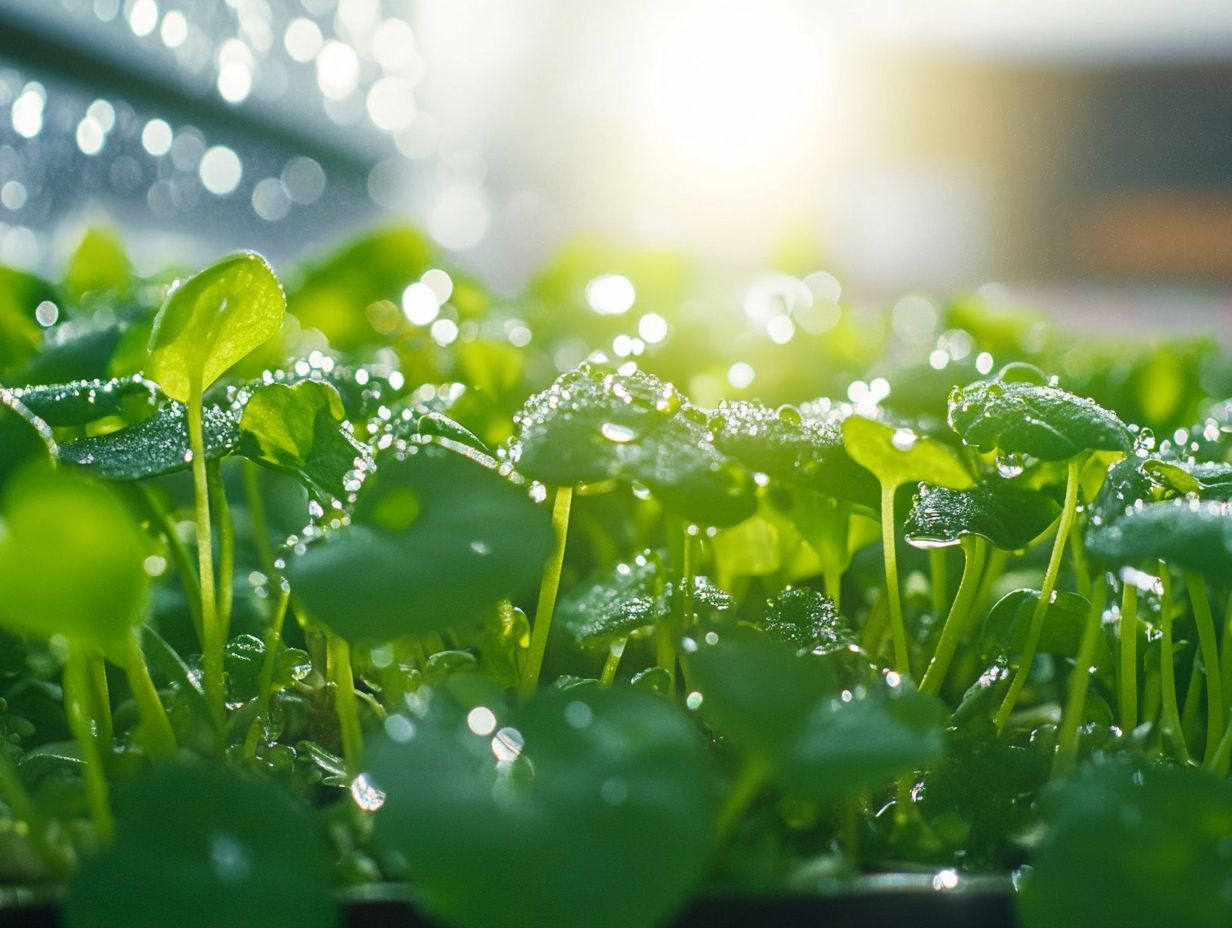
What is the impact of water quality on microgreens?
The quality of water used to grow microgreens can greatly impact their growth, appearance, and overall quality. Microgreens are highly sensitive to changes in water pH, mineral content, and contamination.
How does pH affect microgreens?
The pH level of water can significantly affect the growth and development of microgreens. Ideally, the pH level should be between 5.5 and 6.5 for optimal growth. If the pH is too high or too low, it can cause nutrient deficiencies and hinder growth.
Can contaminated water affect microgreens?
Yes, contaminated water can negatively impact microgreens. This includes the presence of bacteria, chemicals, or heavy metals, which can be harmful to both the growth of the microgreens and the health of those consuming them.
Why is mineral content important for microgreens?
Minerals play a crucial role in the growth and development of microgreens. They help with photosynthesis, enzyme activities, and overall plant health. Without proper mineral content in water, microgreens may suffer from stunted growth, discoloration, and nutrient deficiencies.
How can I ensure good water quality for my microgreens?
The best way to ensure good water quality for microgreens is to use filtered or distilled water. This will remove any potential contaminants and provide a neutral pH. You can also test your water for mineral content and adjust as needed to provide the optimal balance for your microgreens.
Are there any alternatives to using tap water for microgreens?
Yes, you can use rainwater, well water, or even water from a fish tank for your microgreens. Just be sure to test the pH and mineral content to ensure it is suitable for growth. Additionally, using organic fertilizers can help provide necessary nutrients for your microgreens and offset any potential water quality issues.


